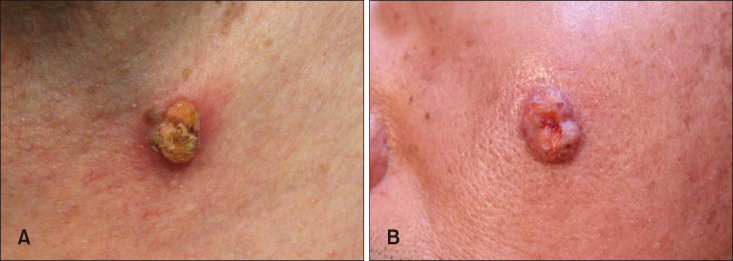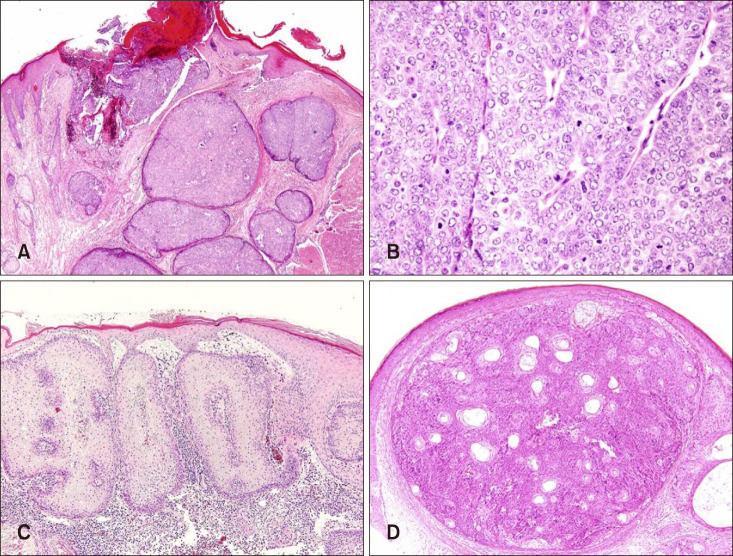Ann Dermatol.
2019 Feb;31(1):14-21. 10.5021/ad.2019.31.1.14.
Clinical Features and Association with Visceral Malignancy in 80 Patients with Sebaceous Neoplasms
- Affiliations
-
- 1Department of Dermatology, Gangnam Severance Hospital, Cutaneous Biology Research Institute, Yonsei University College of Medicine, Seoul, Korea. karenroh@yuhs.ac
- 2Department of Dermatology, Severance Hospital, Cutaneous Biology Research Institute, Yonsei University College of Medicine, Seoul, Korea.
- 3Institute of Vision Research, Department of Ophthalmology, Yonsei University College of Medicine, Seoul, Korea.
- KMID: 2430796
- DOI: http://doi.org/10.5021/ad.2019.31.1.14
Abstract
- BACKGROUND
Sebaceous neoplasm is a rare subgroup of appendageal tumors that differentiate towards sebaceous adnexal structures of the skin and are known to be associated with visceral malignancy.
OBJECTIVE
We aimed to analyze and compare the clinical data including the past history of associated visceral malignancy in patients with sebaceous carcinoma (SC) and benign sebaceous neoplasms (BSN), such as sebaceous adenomas and sebaceomas.
METHODS
We retrospectively reviewed the cases of consecutive patients diagnosed with sebaceous neoplasms. Basic demographic data, past medical history, and clinical data regarding the size, location, and presence of associated visceral malignancies were evaluated.
RESULTS
A total of 80 patients of sebaceous neoplasms (51 SC, 29 BSN) were included. A total of 18 associated visceral malignancies were found in 14 patients (8 SC, 6 BSN). Two patients were diagnosed with subsequent visceral malignancies during the primary work-up process for sebaceous neoplasms. The mean age at diagnosis of the visceral malignancies was 63.9 and 47.5 years for patients with SC and BSN, respectively. The most common site of visceral malignancies was the gastrointestinal (GI) tract. Adenocarcinoma was the most common histologic type of the visceral malignancy noted.
CONCLUSION
We observed associated visceral malignancies in 15.7% of patients with SC and 20.7% with BSN. Our results suggest a need for screening of visceral malignancies, especially of the GI tract, in patients with sebaceous neoplasms.
MeSH Terms
Figure
Reference
-
1. Moscarella E, Argenziano G, Longo C, Cota C, Ardigò M, Stigliano V, et al. Clinical, dermoscopic and reflectance confocal microscopy features of sebaceous neoplasms in Muir-Torre syndrome. J Eur Acad Dermatol Venereol. 2013; 27:699–705. PMID: 22471909.
Article3. Iacobelli J, Harvey NT, Wood BA. Sebaceous lesions of the skin. Pathology. 2017; 49:688–697. PMID: 29078997.
Article4. Park SK, Park J, Kim HU, Yun SK. Sebaceous carcinoma: clinicopathologic analysis of 29 cases in a tertiary hospital in Korea. J Korean Med Sci. 2017; 32:1351–1359. PMID: 28665073.
Article5. Snow SN, Larson PO, Lucarelli MJ, Lemke BN, Madjar DD. Sebaceous carcinoma of the eyelids treated by Mohs micrographic surgery: report of nine cases with review of the literature. Dermatol Surg. 2002; 28:623–631. PMID: 12135523.
Article6. Spencer JM, Nossa R, Tse DT, Sequeira M. Sebaceous carcinoma of the eyelid treated with Mohs micrographic surgery. J Am Acad Dermatol. 2001; 44:1004–1009. PMID: 11369914.
Article7. Harvey DT, Taylor RS, Itani KM, Loewinger RJ. Mohs micrographic surgery of the eyelid: an overview of anatomy, pathophysiology, and reconstruction options. Dermatol Surg. 2013; 39:673–697. PMID: 23279119.
Article8. John AM, Schwartz RA. Muir-Torre syndrome (MTS): an update and approach to diagnosis and management. J Am Acad Dermatol. 2016; 74:558–566. PMID: 26892655.
Article9. Jung KW, Won YJ, Oh CM, Kong HJ, Lee DH, Lee KH. Cancer statistics in Korea: incidence, mortality, survival, and prevalence in 2014. Cancer Res Treat. 2017; 49:292–305. PMID: 28279062.
Article10. Siegel RL, Miller KD, Fedewa SA, Ahnen DJ, Meester RGS, Barzi A, et al. Colorectal cancer statistics, 2017. CA Cancer J Clin. 2017; 67:177–193. PMID: 28248415.
Article



